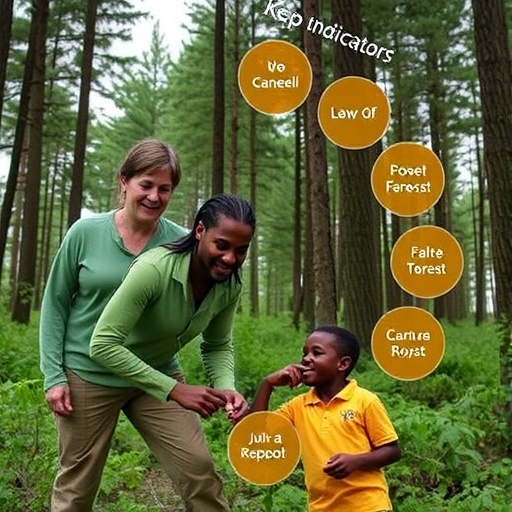In the intricate tapestry of environmental stewardship, community forest management stands as a beacon of hope, particularly in regions like Nepal, where the convergence of biodiversity and human activity creates a unique challenge and opportunity. The study conducted by Pariyar, Bhattarai, and Dhakal delves deep into the dynamics of sustainable forest management, proposing a framework of indicators that could revolutionize how communities interact with their forest resources. As pressures mount from urbanization, climate change, and economic development, understanding these indicators becomes paramount for both ecological preservation and community livelihood.
The essence of active community forest management lies in the collaborative efforts of local populations. It is no longer sufficient to view forests merely as resources; recognizing them as living ecosystems dependent on the interplay of local traditions, biodiversity, and climate is crucial for sustainable management. In their research, the authors emphasize that effective management is predicated on identifying clear, measurable indicators that not only reflect the health of forest ecosystems but also resonate with the socio-economic realities of the communities that rely on them.
One notable aspect of the study is the emphasis on participatory approaches in developing these indicators. By engaging local communities in the identification and measurement of indicators, the researchers advocate for a bottom-up approach that empowers those most directly impacted by forest management decisions. This participatory methodology ensures that the indicators are rooted in the lived experiences of communities, making them more relevant and actionable. Incorporating indigenous knowledge and practices enhances the resilience of forest ecosystems, bridging the gap between tradition and modern management practices.
The authors categorize various indicators into biological, social, and economic measures, providing a comprehensive framework for evaluation. Biological indicators include parameters such as species diversity, forest cover, and the presence of key species, which collectively indicate the health of the ecosystem. Social indicators examine the role of community engagement, governance structures, and local knowledge systems in forest management. Economic indicators assess the financial benefits derived from forest resources, including sustainable timber harvesting, non-timber forest products, and ecotourism opportunities that contribute to local livelihoods.
The analysis extends beyond mere definitions; it challenges existing paradigms of forest management. Traditional top-down approaches often overlook the nuanced interplay between socio-economic factors and environmental health. The researchers argue that effective policies must align with the voices and needs of local communities. This alignment is essential to foster trust and cooperation among stakeholders, ensuring that forest management is viewed as a shared responsibility rather than an imposition from external authorities.
As the study progresses, it highlights the importance of continuous monitoring and adaptive management practices. Forest ecosystems are dynamic and subject to a multitude of external pressures. Therefore, establishing a system of ongoing evaluation based on the defined indicators enables communities to respond to changes effectively, reinforcing the notion of forests as resilient systems capable of adapting to both human and environmental factors.
The research underscores the critical role of governance in facilitating effective community forest management. Effective governance structures that promote transparency, accountability, and inclusivity can significantly enhance the sustainability of forest resources. The authors advocate for the establishment of multi-stakeholder platforms that enable dialogue between local communities, policymakers, and conservation organizations. These platforms can serve as vital hubs for knowledge exchange and collaboration, further strengthening the commitment to sustainable practices.
Moreover, the implications of the study extend beyond Nepal’s borders. The challenges of managing forest resources sustainably are universal, and the lessons gleaned from this research have the potential to inform policies and practices worldwide. By sharing their findings with a broader audience, the authors hope to instigate a global conversation about community-driven forest management approaches that honor local traditions while addressing contemporary environmental challenges.
The study emphasizes that sustainable forest management is not merely an environmental issue but a fundamental aspect of social justice and equitable development. Ensuring that local communities benefit from their forests fosters a sense of ownership and stewardship, which is essential for long-term sustainability. The authors propose that realizing these benefits requires a shift in both perception and practice, urging stakeholders at all levels to rethink their relationship with forests.
Educational initiatives form another cornerstone of the proposed framework. The researchers call for enhanced education and capacity-building programs aimed at equipping local communities with the skills and knowledge needed to implement and monitor the indicators effectively. These initiatives should embrace a holistic view of forest management, integrating ecological principles with social and economic dimensions to foster a more comprehensive understanding of sustainability.
As we navigate the complexities of an increasingly interconnected world, the study by Pariyar, Bhattarai, and Dhakal stands as a significant contribution to the field of sustainable forest management. Their pioneering work illuminates the pathways toward achieving a harmonious balance between ecological integrity and community development. By defining actionable indicators of active community forest management, the authors provide a roadmap for future research and policy-making that prioritizes the voices of those who rely on these vital ecosystems.
In conclusion, the ongoing dialogues surrounding forest management reflect a critical intersection of environmental science, social equity, and sustainability. The vibrant ecosystems that adorn our planet are at a crossroads, and the insights offered by this research are more crucial than ever. As we strive to forge a sustainable future, let us heed the call to reposition community voices at the forefront of forest management, ensuring that our collective actions pave the way for a resilient and thriving planet.
Subject of Research: Community Forest Management Indicators
Article Title: Defining indicators of active community forest management: basis for assessing sustainable forest management in Nepal.
Article References:
Pariyar, S.B., Bhattarai, S. & Dhakal, S. Defining indicators of active community forest management: basis for assessing sustainable forest management in Nepal.
Discov. For. 1, 22 (2025). https://doi.org/10.1007/s44415-025-00017-0
Image Credits: AI Generated
DOI: 10.1007/s44415-025-00017-0
Keywords: Community Forest Management, Sustainable Development, Nepal, Biodiversity, Participatory Approach, Indicators.




